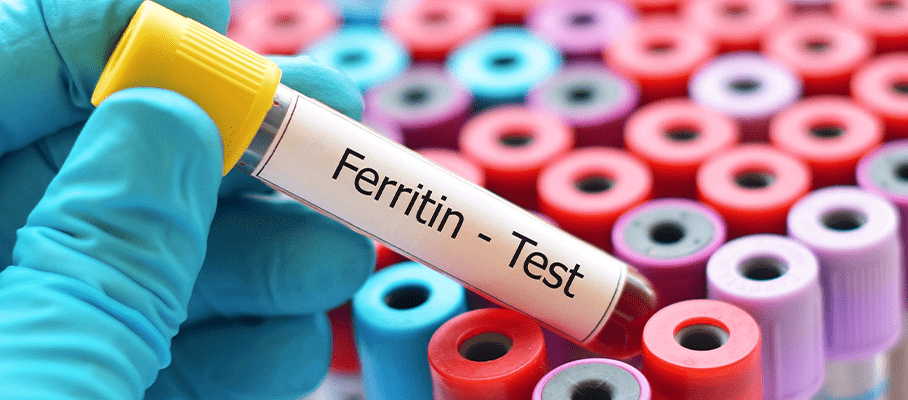iron deficiency anemia
Iron Deficiency Anemia: Causes, Symptoms and Diagnosis
Iron is an essential nutrient for the body's general growth and development. In addition, it serves vital activities like oxygen transport, DNA synthesis, and muscle metabolism. Iron is essential when your body is growing, transforming, or changing. Lack of iron in the diet and increased demand in the body are common causes of iron deficiency in pregnancy and pediatrics. Iron deficiency can result in anemia, which lowers your hemoglobin levels. According to WHO figures, anemia affects 33% of non-pregnant women, 40% of pregnant women, and 42% of children globally. A lack of iron does not pose a threat to life. However, it might cause serious health issues. For instance, it results in dyspnea and exhaustion. The good news is that an iron-rich diet and supplementation can effectively prevent an iron deficiency. Causes of Iron Deficiency Anemia As its name suggests, iron deficiency anemia is caused by a lack of iron, blood flow, and a lack of iron-rich foods in the diet. Below are common causes of iron deficiency anemia. Increased Iron Demand The body's need for iron changes during the different phases of a person's life. For example, the years between childhood and adolescence are vital for growth. As a result, you must ensure you're getting enough iron-rich meals. Additionally, the need for iron rises during pregnancy; this is the prime cause of iron deficiency anemia in pregnancy. Low Absorption Of Iron Several conditions and surgical procedures may hinder iron absorption. For example, Crohn's disease and celiac disease are common causes of iron deficiency anemia. In addition, gastric bypass patients may not be able to absorb iron. These issues might prevent the gut from absorbing iron. Blood Loss Blood loss is among the common causes of iron deficiency anemia in adults. For instance, it could be brought on by blood loss from an injury, menstruation, etc. According to studies, conditions including gastric ulcer, hernia, and colorectal cancer can cause internal bleeding. In addition, heavy periods of women may be more likely to develop anemia. Diet The most common cause of iron deficiency anemia in children and adults is diet. A variety of nutritional factors affect how well iron is absorbed. Non-heme iron, which is of low quality, is present in vegetarian and vegan meals. Heme iron is present in non-vegetarian sources, in contrast. The rate of absorption is higher for heme iron. Vitamin C It is a necessary nutrient for the absorption of iron. Therefore, foods high in vitamin C may transform iron into a readily absorbable form. As a result, a deficiency in foods high in vitamin C is a common cause of iron deficiency anemia in adults. Phytates Some antinutrients interfere with non-heme iron absorption. For example, soybeans, black beans, lentils, split beans, mung beans, unrefined rice, cereals, and mung beans all contain phytates, which are antinutrients. When combined with iron-rich foods, they reduce your iron absorption. Calcium Although the exact mechanism is still unclear, experts think calcium prevents both heme and non-heme iron from being absorbed. Excess calcium causes iron deficiency anemia in pediatrics. Children who consume an excess of cow milk lack iron and have excess calcium, contributing to iron deficiency anemia. Symptoms of Iron Deficiency Anemia Depending on the severity, iron deficiency symptoms can vary. The list of iron deficiency symptoms is provided below. Fatigue Shortness of Breath Irregular Heartbeat/Palpitations Compromised Immune Health Pale Skin Hairfall Sore Mouth Headaches Spoon-Shaped Nails Diagnosis of Iron Deficiency Anemia Anemia can be easily detected through a complete blood count (CBC) with peripheral smear. Through this test it is possible to identify type of anemia and it may further give a clue to do further supplemental tests like i.e., serum iron studies, vitamin levels and identification of abnormal hemoglobinopathy for arriving at the correct diagnosis for the patient. Prevention of Iron Deficiency Anemia Good eating habits can help you avoid iron deficiency. Iron levels in the body may rise with the consumption of iron-rich meals. Here’s some simple dietary advice that can enable you to prevent iron deficiency anemia. Meat Iron content is exceptionally high in poultry and fish. Salmon and tuna are two more types of meat that are high in iron. To combat an iron shortage, incorporate one of these into your diet two or three times per week. Meat sources have a higher absorption rate of iron than plant sources. Eggs Iron, protein, and vitamins are all found in abundance in eggs. For example, about 9.7% of iron is present in every 100 grams of egg. Legumes Lentils are an excellent source of iron for vegetarians. Lentils provide abundant iron; eat it in salad or dal. Fruits and nuts Dry fruits like apricots are a rich source of iron. Iron can also be found in nuts, seeds, beans, tofu, and iron-fortified cereals. Vitamin C Iron absorption requires vitamin C. Vegetarian sources are rich in non-heme iron. They can eat it. Citrus fruits, bell peppers, and broccoli are food sources of vitamin C. Hydration Did you know drinking water is a reliable method of preventing human iron deficiency anemia? Researchers say drinking water locally enriched with iron compounds should be considered and used as a globally accessible means of controlling iron-deficiency anemia. Leafy Greens Leafy greens, such as spinach and kale, are a rich source of folate, which is necessary to avoid anemia. Additionally, leafy vegetables may further improve general wellness. Avoid Antinutrients Antinutrients can impede the absorption of iron. As a result, you should refrain from pairing meals high in iron with antinutrients like tea, coffee, and dairy products. These foods have antinutrients such as tannins, oxalic acids, and phytic acids that bind to iron and stop it from being absorbed. Don't combine calcium and iron-rich foods It is well known that calcium and iron vie for the same receptors. Therefore, according to experts, calcium and iron-rich diets prevent the body from absorbing iron. Conclusion Although iron deficiency is common among people due to poor eating habits, it can also be brought on by non-dietary practices. Iron deficiency is the main contributor to anemia. Healthy eating practices are crucial as a result. Follow the simple food recommendations detailed in the article to prevent iron deficiency and have an overall healthy life. But always remember to get advice from a professional before adding iron supplements. If you experience any symptoms, get the Anemia Profile-Maxi Test for accurate diagnosis.
Ferritin Test: Purpose and Making Sense of Results
Ferritin test is a type of blood test that measures ferritin level in the blood and provides important information about a person's iron levels and overall health. What is Ferritin? Ferritin is an intracellular protein present in most tissues which plays an important role in the storage of intracellular iron, however being a subject of extensive research recently, various other roles have also been ascribed to it. Ferritin is produced by the liver and is stored in cells throughout the body, including in the liver, spleen, bone marrow, and muscle tissue. It is released into the bloodstream as needed to provide iron to the body. This protein plays a crucial role in the body's oxygen transport system as iron is a component of haemoglobin - the protein in red blood cells that carries oxygen to the body's tissues. Low levels of ferritin can lead to iron deficiency anaemia, a condition in which the body does not have enough red blood cells to deliver oxygen to the body's tissues. Testing for ferritin is integral to evaluate a person's iron status and can help diagnose and monitor conditions such as iron deficiency anaemia. How Does Ferritin Help? The serum ferritin is an indirect measure of the total body iron stores and makes a very effective iron delivery system. Ferritin test is a valuable tool for the clinician, both for evaluation of iron-deficiency anemia, and also for evaluation of iron-overload conditions, such as hereditary hemochromatosis and chronic transfusion therapy. Factors That Can Affect Ferritin Levels Ferritin levels can be affected by a variety of factors, including: Age: Ferritin levels typically decline with age, especially in older men. Gender: Ferritin levels are generally higher in men than in women due in part to the difference in body size and muscle mass between the sexes. Diet: A diet low in iron can lead to low ferritin levels. In addition, certain substances in the diet, such as tannins in tea and coffee, can interfere with iron absorption. Alcohol consumption: Excessive alcohol consumption can lead to low ferritin levels due to poor nutrition and damage to the liver, which is responsible for producing ferritin. Certain medications: Some medications, such as nonsteroidal anti-inflammatory drugs (NSAIDs) and corticosteroids, can interfere with iron absorption and lead to low ferritin levels. These factors can affect ferritin levels independently or in combination, and it is crucial to discuss any concerns about ferritin levels with a healthcare provider. Reasons to Test for Ferritin There are several reasons why a healthcare provider may recommend testing for ferritin: To diagnose iron deficiency anaemia To monitor treatment for iron deficiency anaemia To evaluate the cause of abnormal ferritin levels How Ferritin is Tested Ferritin is typically tested using a blood test, which measures the level of this protein in the blood. The test is usually done in a healthcare provider's office or at a laboratory and involves taking a small sample of blood from a vein in the arm using a needle. Other tests that may be done in conjunction with a ferritin test include: Haemoglobin test: This test measures the level of haemoglobin. A low haemoglobin level can indicate anaemia, including iron deficiency anaemia. Complete blood count (CBC): This test measures the number and types of cells in the blood, including red blood cells, white blood cells, and platelets. A CBC can help to diagnose anaemia and determine the cause of anaemia. Iron studies: Iron studies are a group of tests that measure the level of iron in the body and the body's ability to use iron. These tests may include measuring the iron level in the blood, the transferrin saturation (the amount of iron bound to a protein called transferrin), and the total iron-binding capacity (the amount of iron that can be bound to transferrin). It is vital to note that ferritin levels can be affected by other factors, such as inflammation and certain medications, and may not always accurately reflect the body's iron status. Therefore, ferritin testing should be combined with other tests to evaluate a person's iron status. Ferritin Test: Making Sense of the Results The normal range for ferritin levels in the blood may vary depending on the laboratory, but generally, normal ferritin levels are considered to be: For men: 30-400 ng/mL For women: 12-150 ng/mL For children: 12-120 ng/mL Ferritin Test for Iron levels Ferritin serum test is usually a part of a panel of several blood tests routinely ordered to diagnose and manage iron deficiency anemia. If a ferritin test indicates that your level is lower than normal ferritin levels, it indicates your body's iron stores are low and you may have iron deficiency. You could be anemic. However as normal ferritin levels change according to various physiological and pathological conditions, its values must be judged with caution. Low serum ferritin is highly specific for iron deficiency anemia, and is much more convenient than the gold standard method of obtaining a bone marrow biopsy to assess stainable iron. Ferritin normal range varies across laboratories, but levels of 30 to 300 ng/ml are considered normal for men, and 10–200 ng/ml for women. Studies suggested that a level higher than approximately 40 ng/ml should be used to exclude iron deficiency in most patients, whereas a level higher than 70 ng/ml is more appropriate to exclude iron deficiency in patients with inflammation or liver disease where serum ferritin levels are raised as a nonspecific marker of illness. Common Iron Deficiency Anemia Symptoms to Look for: Iron deficiency anaemia is a common condition that occurs when the body does not have enough iron to produce enough red blood cells. It can be caused by various factors, including inadequate intake of iron in the diet, blood loss (such as due to heavy periods or gastrointestinal bleeding), and poor absorption of iron from the digestive tract. It is important to note that these symptoms can also be caused by other conditions, and a diagnosis of iron deficiency anaemia should be confirmed through laboratory testing. Fatigue: Iron deficiency anaemia can cause fatigue due to the lack of oxygen delivered to the body's tissues. Weakness: Iron deficiency anaemia can cause weakness due to the lack of oxygen delivered to the muscles. Headaches: Iron deficiency anaemia can cause headaches due to the lack of oxygen delivered to the brain. Pale skin: Iron deficiency anaemia can cause pale skin due to the lack of oxygen delivered to the skin and the reduced number of red blood cells in the body. Running out of breath when doing even easy daily tasks like walking, climbing stairs, or working out. Irregular heartbeats Dry mouth or a swollen, inflamed, pale, or strangely smooth tongue. Ferritin Test in COVID Ferritin test, in the light of COVID-19 pandemic, has also emerged as an important diagnostic marker. As a mediator of cytokine storm, a form of extreme immune dysregulation associated with fatal outcomes, it is usually ordered as a part of a panel along with other inflammatory markers like ESR, CRP, D dimer and IL-10. Many studies have correlated high ferritin levels with severe COVID disease. In a small study with 20 people with COVID-19, it was found that individuals with severe and very severe COVID-19 exhibited increased serum ferritin level. However, your doctor is the guide here, always follow diagnostic and treatment related guidelines advised to you. Ferritin Test for kidney Conditions In patients with chronic kidney disease serum ferritin is a less robust marker of bioavailable iron. Although most patients on maintenance haemodialysis have a serum ferritin >500 ng/ml, this level does not represent the bioavailable iron and guidelines propose a serum ferritin level of 800 ng/ml as an upper limit for intravenous iron therapy whereas absolute iron deficiency is defined using another laboratory measure (transferrin saturation <20%) or serum ferritin <100 ng/ml. Other Conditions Serum ferritin has been shown to predict the risk of cirrhosis, in patients with hemochromatosis. The risk is extremely low for patients with serum ferritin levels less than 1000 micrograms/litre. Elevated serum ferritin also predicts end-organ involvement in iron overload conditions, such as transfusion-associated iron overload in myelodysplastic syndromes, thalassemia and hemoglobinopathies. Levels less than 1500 ng/ml indicated mostly acceptable iron overload; levels greater than or equal to 3000 ng/ml were specific for significant iron-overload and were associated with liver injury. (Accurate assessment of iron levels is required in those with levels between 1500 and 3000 ng/ml.). Serum ferritin levels may also be raised in many malignancies like neuroblastoma and breast cancer. Exact reason is however unknown but studies suggest that ferritin is merely being a serum maker and does not contribute to cancer etiology. Book your test with us, know the ferritin test cost and access results from the ease of your home. IMPORTANT TO NOTE Always get your results interpreted through a medical professional. Test results may need to be evaluated alongside the clinical symptoms and can require other lab tests as well.
 Home Visit
Home Visit Upload
Upload
















 WhatsApp
WhatsApp